How to Make and Freeze Pesto For Basil All Year Long
Pesto is the perfect way to add a burst of flavor to simple dishes like pasta, pizza, sandwiches, or even grilled vegetables.
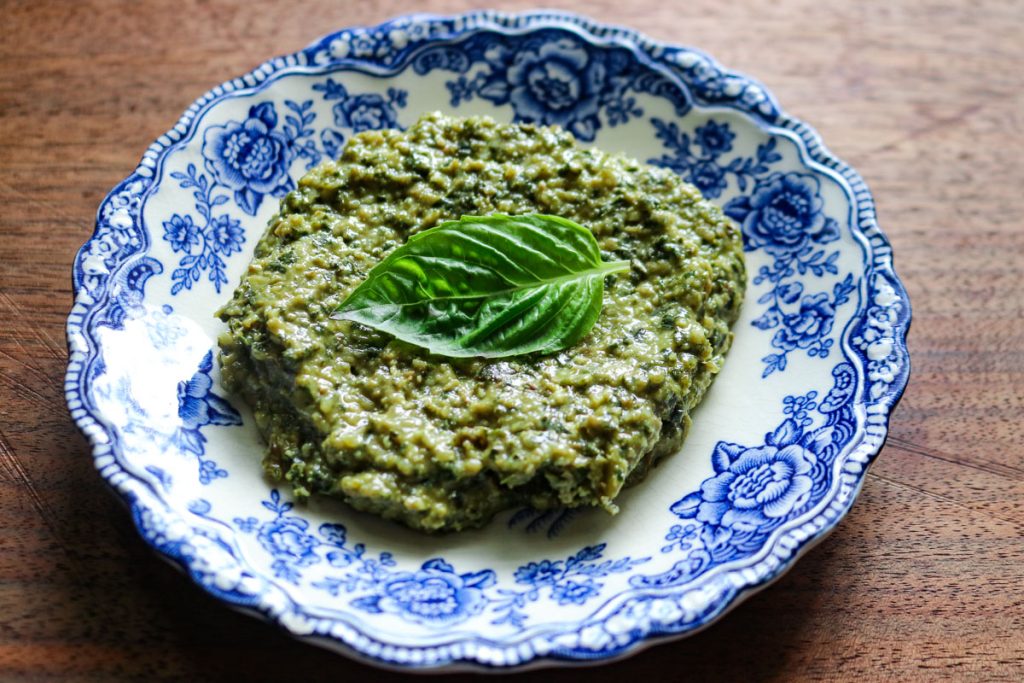
It’s easy to make at home, and when you have an abundance of fresh basil, it’s an excellent way to preserve that vibrant flavor for later. The best part? This flavorful sauce can be frozen so you can enjoy the taste of summer all year long!
What Type of Basil to Use for Pesto
Sweet Italian basil is the star of the show when making pesto. Genovese basil is the traditional choice for its sweet, aromatic flavor. I also like to use lettuce leaf basil and purple basil mixed in with Genovese basil for a robust flavor.

As an Amazon Associate, I earn from qualifying purchases. This post may contain affiliate links, which means I make a small commission at no extra cost to you. See my full disclosure here.
Other types of basil like Thai basil, Mammolo basil, or even lemon basil can be used for a unique twist, but won’t taste the same as traditional pesto.
The key is to use young, tender basil leaves that are vibrant green and free from any yellowing or wilting for the best flavor. As basil leaves age on the stem, they can take on a spicier flavor which isn’t as tasty in pesto. If you are growing your own basil plant you will quickly learn that the more you harvest, the more basil leaves the plant will produce!
If you are buying basil from the grocery store to make your own pesto, look for large bunches of basil (usually sold in cellophane or plastic wrap bundles in the produce section) as you will need 2 cups of packed leaves for this pesto recipe. Be sure to use fresh basil leaves instead of dried. Dried basil leaves are much more potent and do not have a sweet flavor. Dried basil leaves simply don’t have the fresh flavor that this dish requires.
Helpful Kitchen Tools for Making and Freezing Pesto
Making homemade pesto doesn’t require any specialty equipment, but these tools will help make the process easier:
Ingredients for Basic Homemade Pesto
Here’s my favorite recipe for making homemade pesto:
- 2 cups packed fresh basil leaves
- 1/2 cup parmesan cheese
- 1/4 cup pine nuts, walnuts or pecans (use whichever you prefer- I like to use walnuts as a more economical option, but pine nuts are traditional)
- 1 tablespoon minced garlic
- A splash of lemon juice (for brightness, the acidity helps to maintain the pesto’s vibrant green color)
- 1/2 cup extra virgin olive oil
- Salt and pepper to taste
This recipe can be easily doubled or even quadrupled! Making big batches of fresh basil pesto is one of my favorite ways to preserve our homegrown basil!
How to Make Pesto in a Food Processor
Making pesto in a food processor is fast and easy! Here’s how to do it:
- Prepare Your Ingredients: Wash and pat dry your basil leaves. Mince the garlic and have your olive oil and seasonings ready.
- Blend the Basil and Nuts: Add the basil leaves and walnuts (or pecans) to your food processor. Pulse a few times to break them down slightly.
- Add Garlic and Lemon Juice: Add the minced garlic and a splash of lemon juice, then pulse again to mix it all together. Add in the parmesan cheese.
- Slowly Add Olive Oil: With the food processor running, slowly pour in the olive oil until the mixture becomes a smooth, creamy paste. You may need to stop and scrape down the sides with a spatula a couple of times to ensure everything is well blended.
- Season and Adjust: Taste your pesto and add salt, pepper, or more lemon juice if desired. Pulse a few more times to combine.
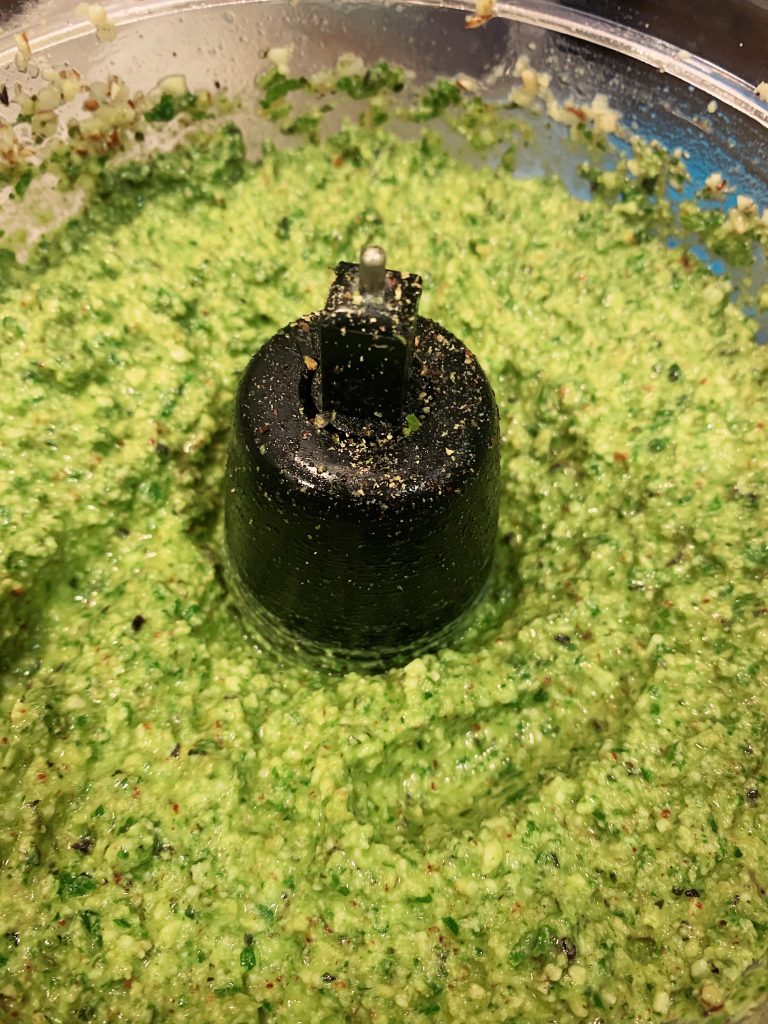
And that’s it! Your homemade pesto is ready to use immediately or to freeze for later.
Does Fresh Pesto Freeze Well?
Yes, fresh pesto freezes beautifully! Freezing pesto is a great way to preserve the fresh basil flavor, so you can enjoy it long after basil season has passed. The flavors actually deepen and develop while frozen, and the texture stays pretty good once thawed, making it perfect for pasta, pizza, or any dish that needs a little extra flavor.
How to Freeze Pesto Without It Turning Brown
To keep your pesto looking fresh and green when frozen, follow these tips:
- Use Olive Oil: After making your pesto, pour a thin layer of olive oil over the surface before sealing the container. This “fat cap” layer helps protect it from oxidizing and keeps the color vibrant. It’s like summer in a bottle!
- Freeze in Portions: Freezing pesto in small portions is a great way to avoid thawing the whole batch at once. Ice cube trays work wonderfully for this. However, if you are a pesto fiend like me, you might as well thaw out a whole jar. It won’t go to waste! Pesto can be frozen in ice cube trays, small jars or a freezer bag.
- Lemon Juice: The splash of lemon juice you add to your pesto will help keep it from turning brown while frozen.
- Minimize Air Exposure: To prevent oxidation, use airtight containers, freezer bags, or vacuum-sealed bags to store your pesto. Try to squeeze out as much air as possible before sealing. Alternatively, layering a thin layer of olive oil on top will prevent oxidation.
Best Ways to Store Homemade Pesto
- Short-Term Storage: If you plan to use your pesto in a few days, store it in an airtight container in the fridge. For extra freshness, drizzle a thin layer of olive oil on top before sealing.
- Long-Term Storage (Freezing): Freezing is the best option for longer storage. You can either freeze your pesto in small jars (I prefer half pint jars) or ice cube trays. If you only plan to use small amounts here and there, ice cube trays will be best. However, if you like to make pesto heavy dishes like pesto based salad dressings, Salmon with pesto ranch or chicken pesto pasta, where you will need at least a cup of pesto, freezing your pesto in a half pint jar will work better.
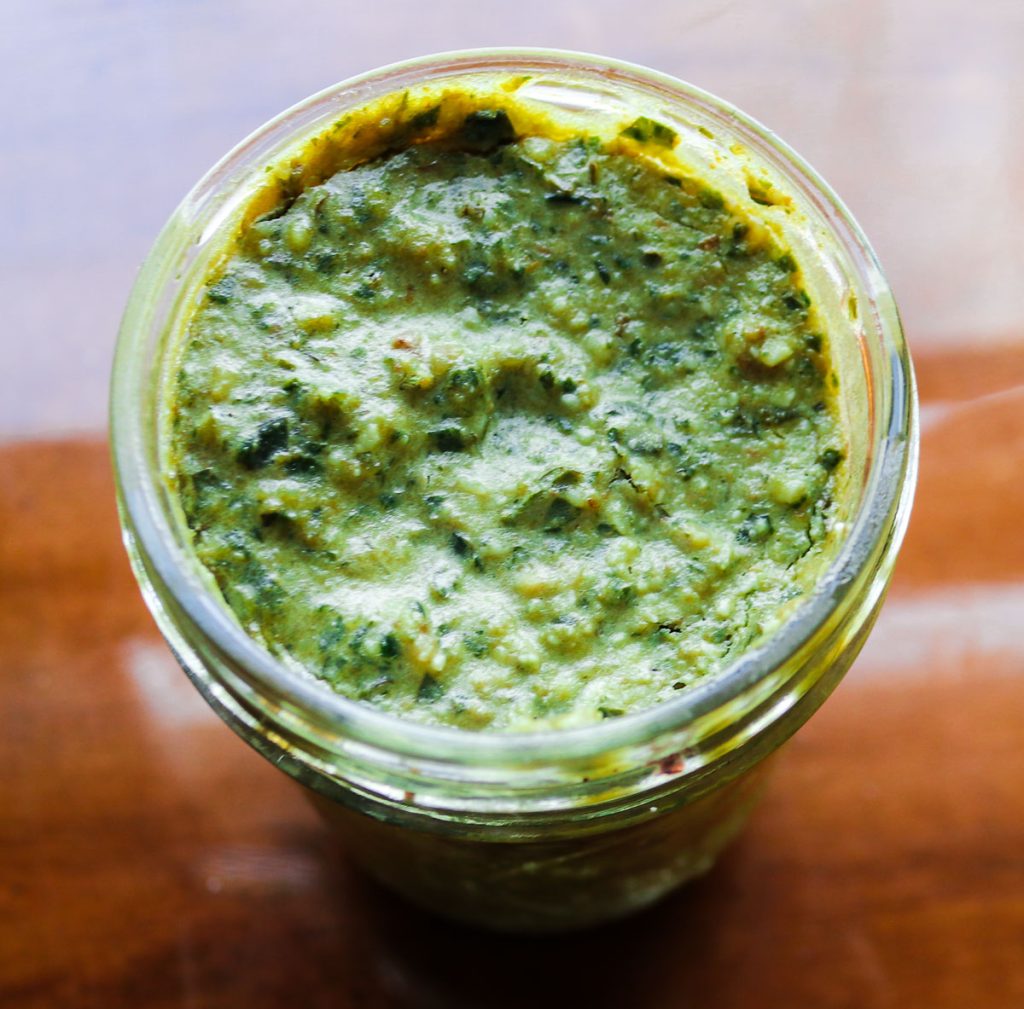
If you are freezing in freezer safe jars, be sure to leave several inches (at least 2-3 inches) of headspace in the jar to allow for expansion. This prevents the glass from cracking.
If you are freezing in ice cube trays, flash freeze the pesto in the ice cube tray. Then once frozen, pop the pesto cubes out and place in a freezer safe bag, removing as much air as possible.
Can You Freeze Pesto in Ziploc Bags?
Absolutely! Ziploc bags are a fantastic way to freeze pesto, especially if you want to save space in the freezer while still preserving larger portions of pesto. Here’s how to do it:
- Pour the pesto into a Ziploc bag and press out as much air as possible.
- Lay the bag flat in the freezer so the pesto freezes in an even thin layer.
- Once frozen, you can stand the bag upright for easy storage.
Freezing pesto in this way also makes it easy to defrost just the amount you need as you can “snap” off bits of the frozen pesto to suit your needs.
Making and freezing homemade pesto is the best way to capture the fresh summertime flavor of basil and enjoy it all year long.
By using the right ingredients and storing methods, you can ensure your pesto stays flavorful and vibrant when thawed.
Printable Recipe Card:
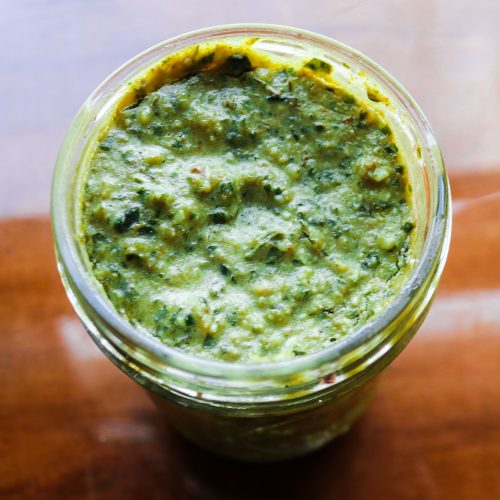
Basil Pesto: How to Make and Freeze
Equipment
- food processor
Ingredients
- 2 cups packed fresh basil leaves
- 1/2 cup parmesan cheese
- 1/4 cup pine nuts walnuts or pecans (use whichever you prefer- I like to use walnuts as a more economical option, but pine nuts are traditional)
- 1 tablespoon minced garlic
- A splash of lemon juice for brightness, the acidity helps to maintain the pesto’s vibrant green color
- 1/2 cup extra virgin olive oil
- Salt and pepper to taste
Instructions
- Prepare Your Ingredients: Wash and pat dry your basil leaves. Mince the garlic and have your olive oil and seasonings ready.
- Blend the Basil and Nuts: Add the basil leaves and walnuts (or pecans) to your food processor. Pulse a few times to break them down slightly.
- Add Garlic and Lemon Juice: Add the minced garlic and a splash of lemon juice, then pulse again to mix it all together. Add the parmesan cheese.
- Slowly Add Olive Oil: With the food processor running, slowly pour in the olive oil until the mixture becomes a smooth, creamy paste. You may need to stop and scrape down the sides with a spatula a couple of times to ensure everything is well blended.
- Season and Adjust: Taste your pesto and add salt, pepper, or more lemon juice if desired. Pulse a few more times to combine.
- Short-Term Storage: If you plan to use your pesto in a few days, store it in an airtight container in the fridge. For extra freshness, drizzle a thin layer of olive oil on top before sealing.
- Long-Term Storage (Freezing): Freezing is the best option for longer storage. You can either freeze your pesto in small jars (I prefer half pint jars) or ice cube trays. If you only plan to use small amounts here and there, ice cube trays will be best. However, if you like to make pesto heavy dishes like pesto based salad dressings, Salmon with pesto ranch or chicken pesto pasta, where you will need at least a cup of pesto, freezing your pesto in a half pint jar will work better.
Notes
Frozen Pesto FAQ:
How Long Does Homemade Basil Pesto Last?
Homemade basil pesto can last about 5–7 days when stored in an airtight container in the refrigerator. If you want to keep it longer, freezing it is the best option. When frozen properly, pesto can last for up to a year! I typically make enough jars of pesto to last us until the next year’s basil plants are producing leaves.
What is a Substitute for Pine Nuts in Pesto?
Pine nuts, while delicious, are often tricky to find in small grocery stores and quite expensive! If you can’t find or prefer not to use pine nuts in your pesto, walnuts or pecans are great substitutes. I prefer to use walnuts in my pesto. While they add a slightly different texture than pine nuts, but they still add a rich nutty flavor to the sauce.
Do You Use Basil Stems in Pesto?
No. Only the leaves of basil are used for pesto as the stems are tough and add much less flavor. For the best texture and taste, it’s best to discard the stems and use fresh, tender basil leaves.
What Cheese is Best for Pesto?
The most common cheeses used in pesto are Parmesan or Pecorino Romano. Both cheeses are hard, salty, and packed with flavor, which complements the fresh basil and nuts perfectly. I prefer to use parmesan in my pesto.
I will say, in a sauce this simple, it is best to go with the highest quality ingredients you can afford. While I have used the popular parmesan found in the green can in a pinch, it isn’t preferable.
If at all possible, skip the canned green parmesan for this recipe and go with a higher quality cheese!

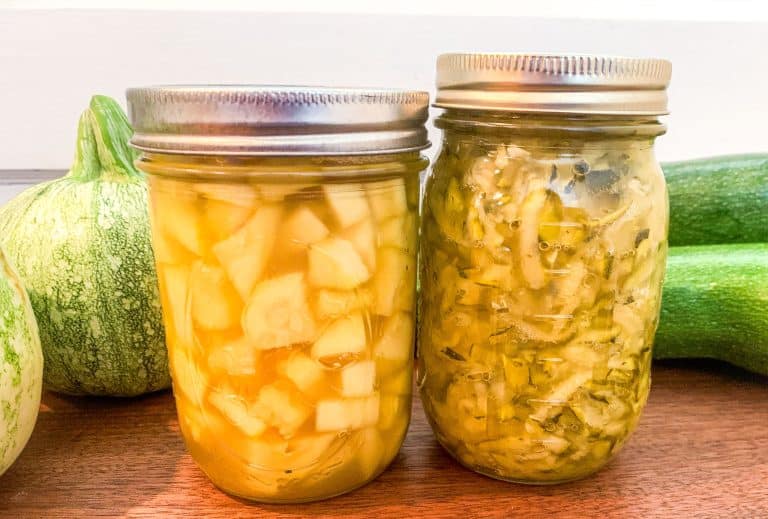
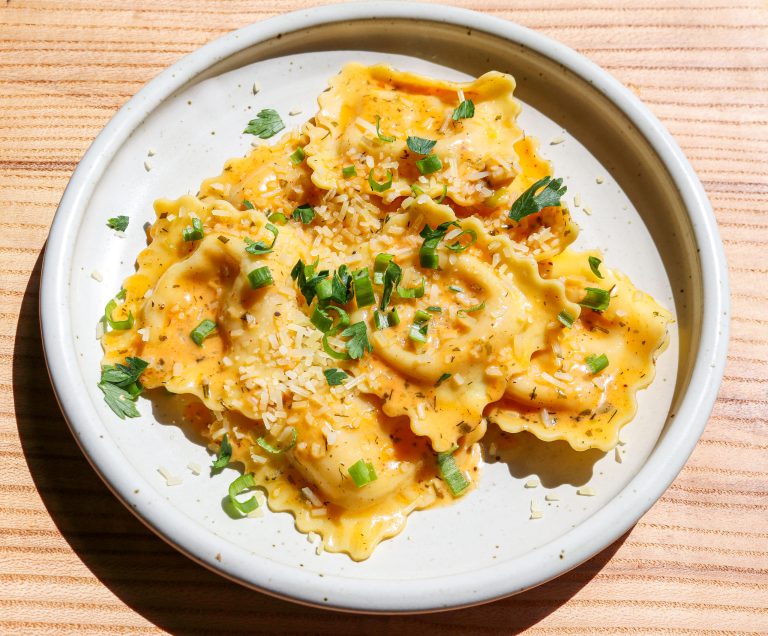




When do you add the cheese to the blender? It’s not mentioned in the instructions.
I like to add the parmesan cheese when I add in the lemon juice and garlic. I have updated the recipe to be clearer! Thank you for letting me know, I hope that helps! 🙂